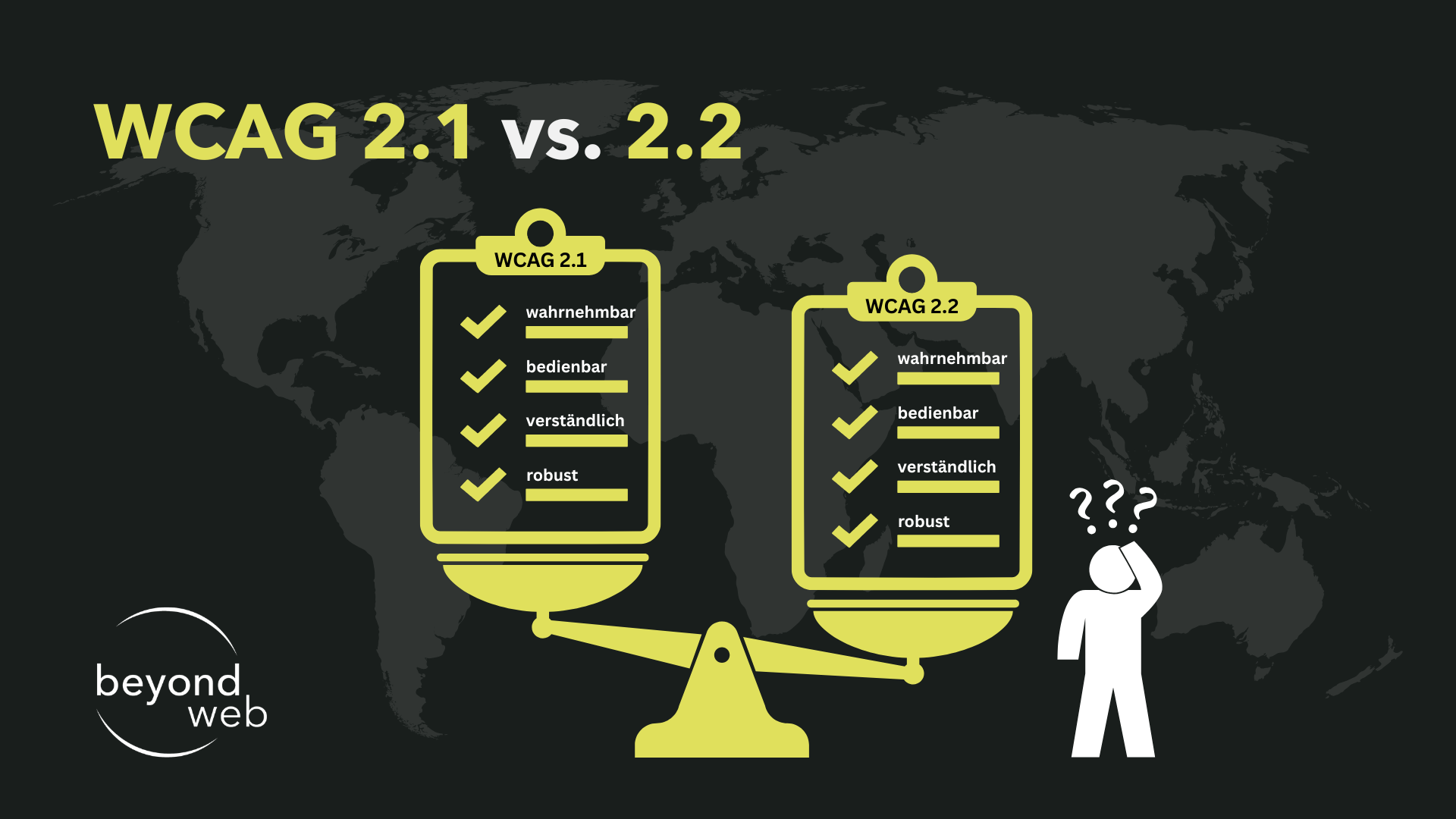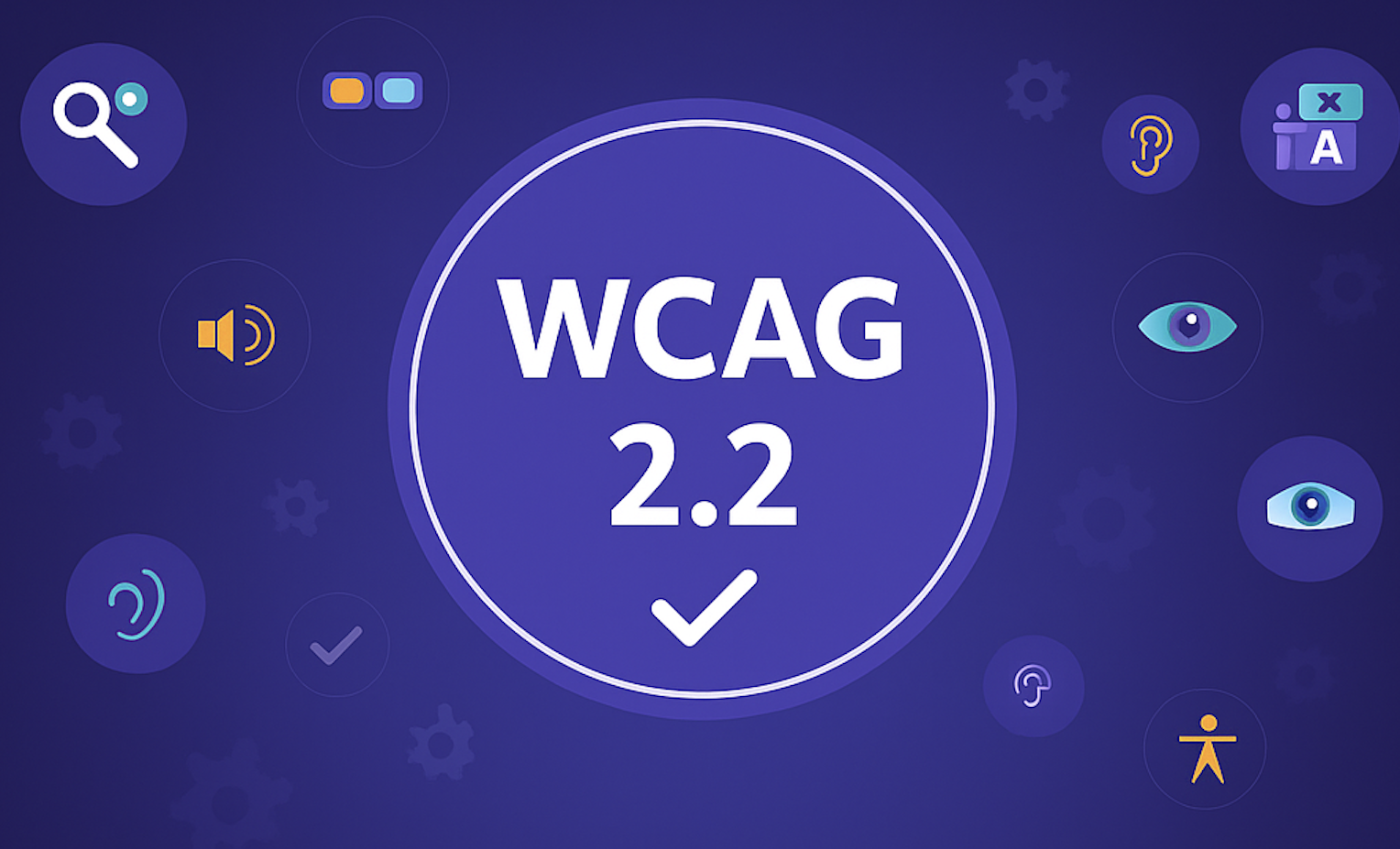Methode zur Berechnung der benötigen Linkanzahl
Eine pauschale Antwort auf die Frage, wie viele Backlinks eine Website benötigt, ist nicht möglich, da dies von zahlreichen Faktoren wie der Branche, dem Wettbewerb und den spezifischen Zielen der Website abhängt.
Je stärker die Konkurrenz, desto höher sind in der Regel die Investitionen im Bereich SEO. Eine höhere Investition im Bereich SEO bedeutet für mich in den meisten Fällen auch eine höhere Anzahl an Backlinks.
Wenn ich als Unternehmen in einem solchen Wettbewerbsfeld mithalten möchte, bin ich in den meisten Fällen auch auf eine höhere Anzahl an Backlinks angewiesen.
Um eine grobe Einschätzung zu erhalten, wie viele Backlinks benötigt werden, empfehle ich immer eine Wettbewerbsanalyse durchzuführen.
Die Wettbewerbsanalyse ist für mich ein zentrales Element, um einerseits eine Website in den Suchmaschinen nach vorne zu bringen und andererseits die Linkstruktur und Strategie der Konkurrenten besser zu verstehen.
Backlink-Wettbewerbsanalyse
Innerhalb einer Backlink-Wettbewerbsanalyse betrachte ich nicht nur die reine Zahl der Backlinks, die meine Wettbewerber haben, sondern auch die Qualität dieser Links.
Vor allem Backlinks, die von Seiten mit einer hohen Domain-Autorität (DA) kommen, sind relevant. Diese Links sind in der Regel schwerer zu erhalten und können daher wertvoller sein.
Auch die Herkunft der Links ist ein wichtiger Indikator für die Qualität eines Backlinkprofils (Stichwort: thematische Relevanz).
Die thematische Relevanz eines Backlinks leitet sich davon ab, wie relevant das «Thema» der verlinkenden Domain zum Thema meiner verlinkten Domain steht.
Ein Beispiel zur Veranschaulichung: Stell dir vor, du betreibst einen Hundeblog und erhältst einen Backlink von einer Autotuning-Website. In diesem Fall würde ich die thematische Relevanz des Links als niedrig einstufen.
Erhältst du für einen Hundeblog hingegen einen Backlink von einer Tierklinik oder einer Hundefuttermarke, würde ich die thematische Relevanz des Backlinks als hoch einstufen.
Bei den obigen Beispielen ist die Einstufung der thematischen Relevanz relativ eindeutig. Es gibt jedoch auch Fälle, bei denen die Einstufung nicht eindeutig klar ist.
Die Einstufung der thematischen Relevanz ist aus meiner Sicht immer auch subjektiv geprägt und kann leider nicht durch klare quantitative Parameter vorgenommen werden.
Tools für die Wettbewerbsanalyse
Um die Wettbewerbsanalyse zu realisieren, empfehle ich marktführende SEO-Tools wie Ahrefs. Diese bieten tiefgreifende Analysemöglichkeiten, um die Anzahl sowie auch die Qualität der Backlinks der Wettbewerber zu untersuchen.
Durch Ahrefs kann demnach nicht nur die Anzahl der Backlinks analysiert werden, sondern auch die Qualität der Backlinks.
Das ist einerseits möglich durch die Nachvollziehbarkeit des Domain Ratings (DR), aber auch durch andere Qualitätsparameter wie die Anzahl der verweisenden Domains oder das Verhältnis der eingehenden und ausgehenden Backlinks.
Ausserdem kannst du mit Hilfe von Ahrefs ermitteln, von welchen Websites die Links kommen, welche Ankertexte verwendet werden und wie das Linkprofil über die Zeit gewachsen ist.
Das ist wichtig, um nachzuvollziehen, wie die Konkurrenten innerhalb der eigenen Branche ihre Backlink-Profile aufbauen und wie schnell sie dies tun (Stichwort: Link Velocity).
Neben Ahrefs gibt es aber auch noch weitere Tools, die verwendet werden können. Dabei lohnt es sich die Wettbewerbsanalyse auf mehrere SEO-Tools zu stützen, da unterschiedliche Tools auf unterschiedliche Datenbanken zurückgreifen.
Beispielsweise kann, für die Ermittlung der Qualität von Backlinks, Sistrix ein gutes Tool sein, um die Sichtbarkeit mittels des Sichtbarkeitsindex (SI) zu ermitteln.
In vielen Fällen kann es auch sinnvoll sein, eine professionelle SEO Agentur herbeizuziehen. Dies einerseits, weil eine Wettbewerbsanalyse mehrere SEO-Tools beansprucht, welche schnell mehrere Tausend Schweizer Franken an jährlichen Kosten verursachen.
Andererseits benötige ich für die Beurteilung gewisser Qualitätskriterien eine gewisse Expertise und Erfahrung, um die von den Tools zur Verfügung gestellten Daten richtig zu interpretieren.
Eine Wettbewerbsanalyse bildet deshalb immer die Grundlage einer soliden Backlink-Strategie und sollte seriös und umfassend durchgeführt werden.
Was gibt es beim Backlink Aufbau zu beachten?
Im Folgenden werde ich die wichtigsten Faktoren beim Backlink Aufbau genauer erläutern:
Qualität wichtiger als Quantität
An erster Stelle ist zu betonen, dass nicht, wie vielleicht einige vermuten, die reine Anzahl der Backlinks massgeblich entscheidend ist, sondern vor allem die Qualität der Backlinks.
Einige hochwertige Links von autoritären und relevanten Websites können einen weit grösseren Einfluss auf die Suchmaschinen-Rankings haben als Hunderte von Links von niedriger Qualität.
So ist beispielsweise ein Link von einer angesehenen Zeitschrift, Universität oder auch einer Forschungseinrichtung möglicherweise wertvoller als mehrere hundert Links von kleinen, unbekannten Blogs.
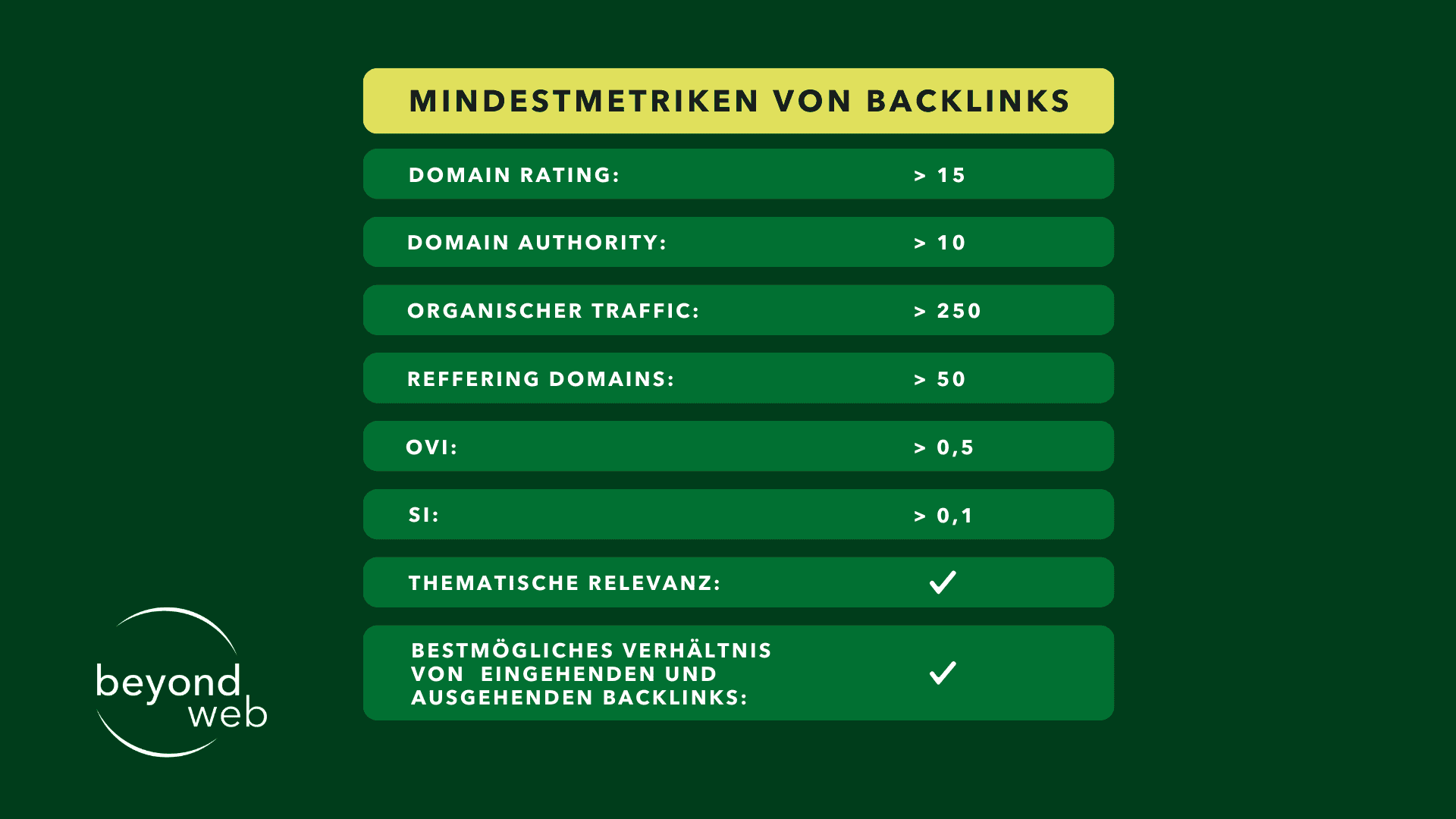
Wenn es darum geht festzulegen, wie viele Links platziert werden sollten, sollte man sich immer an der Linkanzahl der top-gerankten Unternehmen in der eigenen Branche orientieren.
Grundsätzlich gilt bei der Linkplatzierung jedoch meistens der Grundsatz «weniger ist mehr».
Zu viele (qualitativ schlechte) Backlinks können einer Suchmaschine wie Google negativ Signale aussenden, wodurch sich nicht nur dein Ranking verschlechtern kann, sondern deine Website sogar als Spam wahrgenommen wird.
Das richtige Mass an Qualität und Quantität ist dementsprechend sehr entscheidend für das Ranking meiner Domain und muss als einer der wichtigsten Faktoren im Linkaufbau berücksichtigt werden.
Die Wichtigkeit von Ankertexten
Der Ankertext ist ein wichtiger Aspekt im Bereich der Suchmaschinenoptimierung und insbesondere beim Aufbau von Backlinks.
Hierbei handelt es sich um den sichtbaren, klickbaren Text, der auf eine andere Seite verweist.
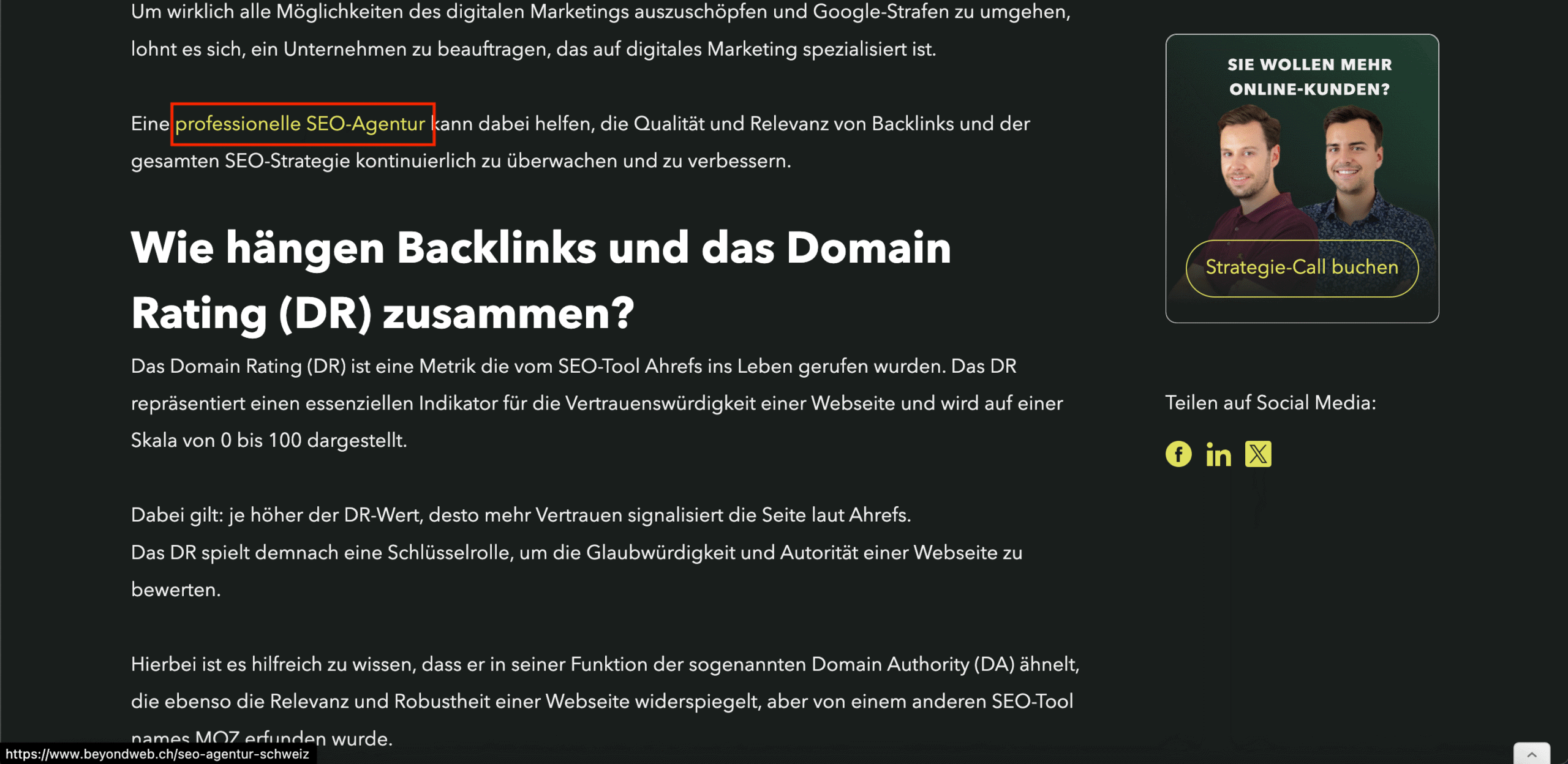
Der Ankertext kann nicht nur für eine bessere Navigation deiner Websitebesucher von Bedeutung sein, sondern spielt auch eine gewichtige Rolle dabei, wie die Suchmaschine den Inhalt deiner Webseite interpretiert und einordnet.
Suchmaschinen nutzen Ankertexte, um den Inhalt der verlinkten Seite besser zu verstehen und einzuordnen. Das heisst, der Ankertext gibt Google Hinweise darauf, welches Thema oder welche Themen die Zielseite behandelt.
Wenn beispielsweise viele Websites mit dem Ankertext „Webdesign“ auf eine andere Seite verlinkt sind, geht die Suchmaschine davon aus, dass die verlinkte Seite relevant für den Suchbegriff „Webdesign“ ist.
Es ist für mich unerlässlich, beim Aufbau von Backlinks eine natürliche Varianz in den Ankertexten zu berücksichtigen. Das bedeutet, dass nicht alle Links denselben Ankertext haben sollten.
Eine Vielfalt an Ankertexten, die von verschiedenen Seiten stammen, wirkt aus Sicht von Google authentischer und natürlicher.
Grundsätzlich unterscheide ich zwischen 5 verschiedenen Arten von Ankertexten:
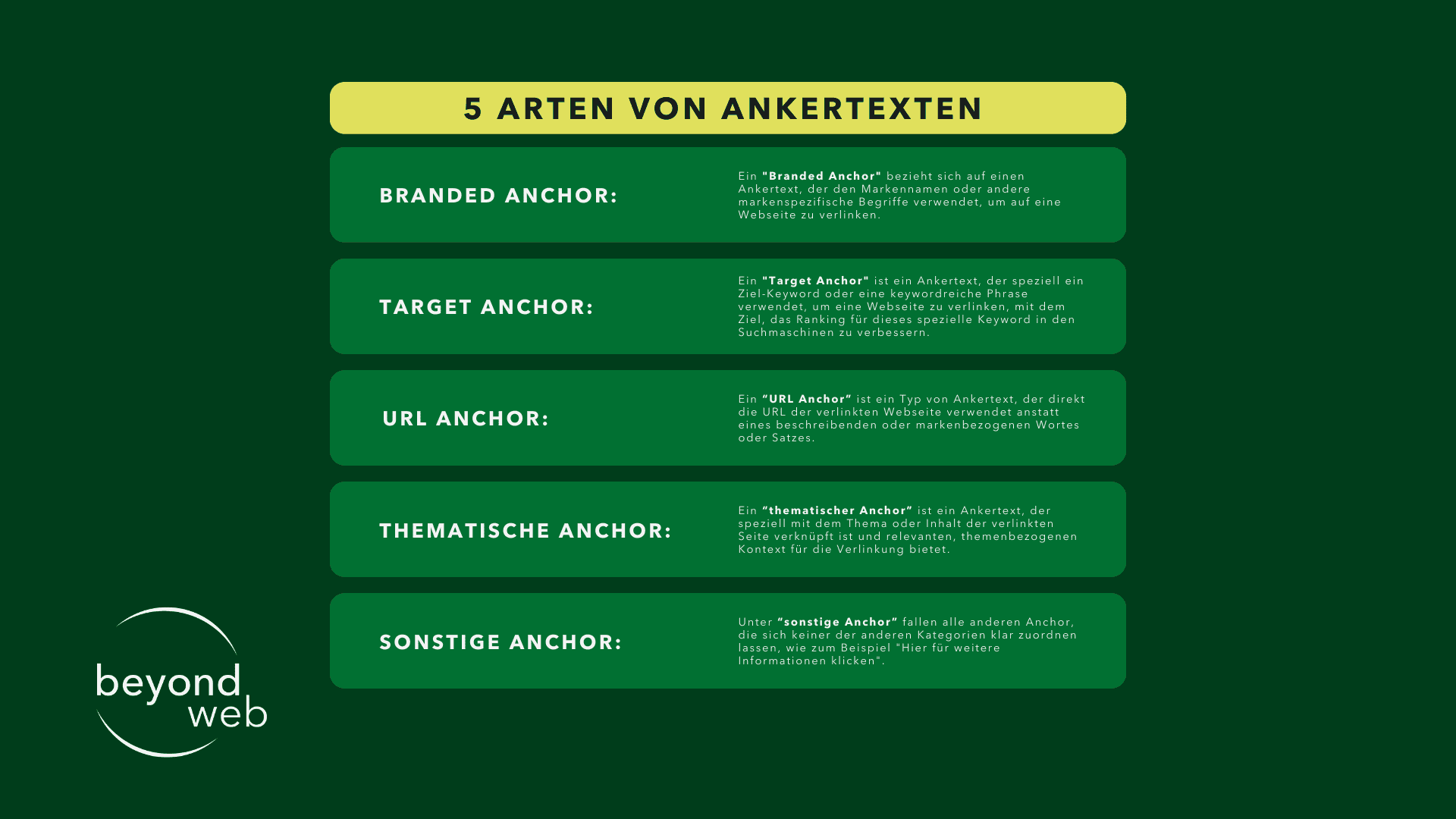
Es gibt auch zahlreiche andere Kategorisierungsschemata von Ankertexten.
Wichtig ist jedoch primär nicht, wie ich die Ankertexte kategorisiere, sondern dass eine konsequente Kategorisierung vorgenommen wird.
Dein Ziel muss es sein, eine möglichst natürliche Verteilung des Linkprofils anzustreben.
Das bedeutet, dass die Ankertexte sowohl exakte Übereinstimmungen mit einem Fokus-Keyword enthalten (Target Anchor), als partielle Übereinstimmungen mit thematisch verwandten Begriffen (Thematischer Anchor), sowie dem eigenen Markennamen (Branded Anchor), URLs und sonstigen Formen von Ankertexten.
Während Ankertexte dazu genutzt werden können, der Suchmaschine relevante Signale zu senden, solltest du gleichzeitig darauf achten, dass gerade die Target Anchors mit einem exakten Fokus-Keyword, sowie thematische Anchors, nicht exzessiv verwendet werden.
Eine übermässige Verwendung dieser Ankertexte wird von Seiten Google als Manipulation eingestuft.
Dies kann im schlimmsten Fall dazu führen, dass deine Keyword-Rankings systematisch zurückgestuft werden
Bei der Verwendung von Ankertexten sollte also strategisch agiert und auf eine ausbalancierte Mischung verschiedener Ankertexte geachtet werden.
Ein strategisch umsichtiger und durchdachter Umgang mit Ankertexten im Linkaufbau sorgt dafür, dass deine Website positive Signale an eine Suchmaschine sendet, die Relevanz und Autorität der Website in den Augen der Suchmaschine gesteigert und zugleich ein Risiko von Strafen durch unnatürliche Linkmuster minimiert wird.
Verteilung zwischen DoFollow und NoFollow Backlinks
Backlinks können grundsätzlich in zwei Hauptkategorien unterteilt werden: externe und interne Backlinks.
Während interne Links Verlinkungen innerhalb meiner eigenen Website sind, stellen externe Links eine Verlinkung dar, die von einer anderen Website auf meine eigene Website verweisen.
Doch was sind nun DoFollow und NoFollow Links?
DoFollow- und NoFollow-Links gehören zum Bereich der externen Links.
1. DoFollow-Links
DoFollow-Links tragen stärker zur SEO bei, da sie sogenannten Linkjuice (Linksaft) übertragen. Das bedeutet, dass ein solcher Link die «Power» der verlinkenden Domain an meine verlinkte Website weitergibt.
Grundsätzlich sind Backlinks, egal welcher Art, standardmässig DoFollow-Links.
Je mehr DoFollow Links meine Website besitzt, desto grösser das Vertrauen seitens von Google in meine Website, weil dadurch die «Autorität» der Domain innerhalb des Internets (nach Definition des Google-Algorithmus) steigt.
2. NoFollow-Links
NoFollow-Links stehen im Gegensatz zu DoFollow-Links und übermitteln keinen direkten Linksaft. Das heisst, sie übertragen keinen Linkjuice und werden von einer Suchmaschine, wie beispielsweise Google, nicht berücksichtigt.
Wichtig zu wissen ist, dass Links nicht automatisch als NoFollow vermerkt sind.
Möchte ich einen bestimmten Link als NoFollow markieren, weil es sich beispielsweise um einen Spam-Link handelt, also ein Link von niedriger Qualität, der das Ranking meiner Domain negativ beeinflusst, muss dieser Vorgang manuell über zum Beispiel das Verändern beziehungsweise Anpassen des HTML Codes vorgenommen werden.
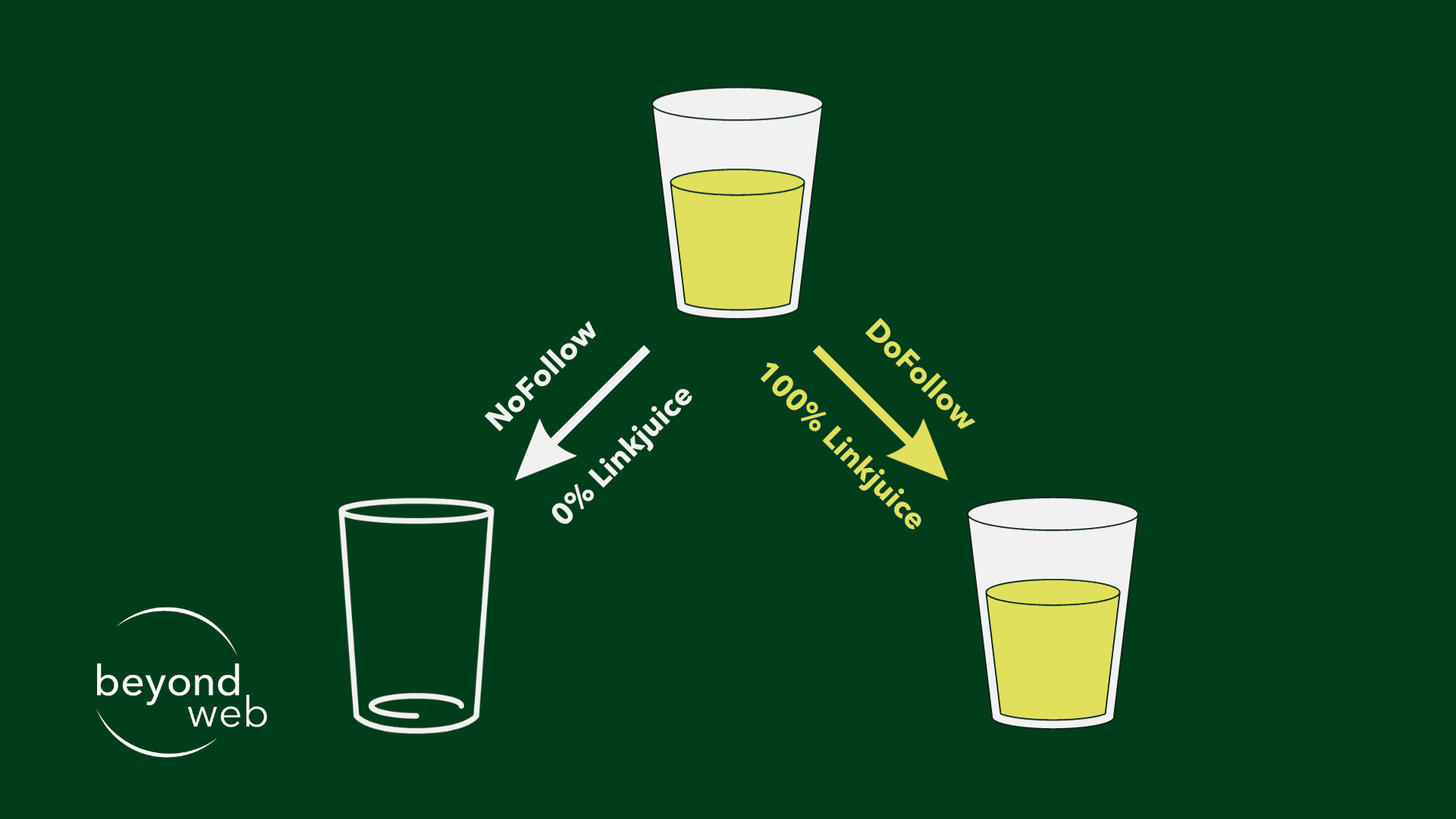
Wichtig ist es für mich, ein natürliches Verhältnis zwischen beiden Typen von Links aufzubauen, um Authentizität und Vertrauenswürdigkeit vis-à-vis der Suchmaschine zu signalisieren.
Wenn beispielsweise 90% aller meiner Backlinks DoFollow Links sind, kann das von der Suchmaschine wie Google als unnatürlich eingestuft werden.
Eine Verteilung von beispielsweise 70% DoFollow und 30% NoFollow wirkt dagegen deutlich natürlicher und dementsprechend auch vertrauenswürdiger.
Jedoch gibt es keine Einheitsverteilung zwischen DoFollow- und NoFollow-Links, die für alle Keywords, Branchen etc. pauschal angewendet werden kann.
In der Regel solltest du die Verteilung von DoFollow und NoFollow Links immer von den 3-5 organisch bestplatzierten Konkurrenten ableiten.
Eine solche Konkurrenzanalyse des Linkprofils der Konkurrenz könntest du beispielsweise mit dem Site-Explorer der SEO-Software Ahrefs durchführen.
Backlink-Aufbau bei neuen Domains
Falls deine Domain erst frisch registriert wurde, stellt der Backlink-Aufbau häufig eine besonders herausfordernde Aufgabe dar.
Dies ist so, weil man zu Beginn sprichwörtlich bei 0 anfängt und noch keinerlei Backlinks oder Brand Reputation aufgebaut hat.
Dennoch gibt es eine Reihe effektiver Taktiken und Strategien, die du nutzen kannst, um dein Backlink-Profil schnell aufzubauen und dadurch deine Sichtbarkeit online zu erhöhen.
Einige der effektivsten Linkaufbau-Strategien werde ich im folgenden Abschnitt genauer erläutern:
Qualitativ hochwertige Inhalte erstellen
Zunächst steht für mich die Erstellung von qualitativ hochwertigen, informativen und einzigartigen Inhalten bei einer neuem Domain immer im Vordergrund.
Diese Strategie fördert natürliche Verlinkungen von andere Websites (wenn sie richtig praktiziert wird).
Der Linkaufbau-Mechanismus ist folgender: Bei der Generierung von Content, der sowohl informativ als auch nützlich für deine Zielgruppe ist, steigt die Wahrscheinlichkeit, dass andere Websites auf deine Inhalte verlinken.
Besonders gut schneiden dabei Inhalte ab, die beim Teilen einen Mehrwert bieten können, wie beispielsweise Infografiken, Statistiken oder Experten-Interviews.
Das wiederum kann dazu führen, dass Besucher, die zum Beispiel über einen solchen Link von einer anderen Seite auf deine Webseite gelangen, eine längere Zeit auf deiner Homepage verweilen.
Das Erstellen qualitativ hochwertiger Inhalte kann nicht nur das Entstehen von natürlichen Backlinks durch andere, themenrelevante Webseiten fördern, sondern durch diese Backlinks kann auch die Anzahl der Besucher so wie deren Aufenthalt auf meiner Webseite gesteigert werden kann.
Sowohl Backlinks, als auch Website-Traffic wird von Google als sehr positives Signal wahrgenommen und kann dein Ranking für bestimmte Keywords signifikant verbessern.
Grundsätzlich muss ich an dieser Stelle jedoch realistisch einordnen, dass das organische Linkbuilding oftmals nicht von heute auf morgen passiert.
Damit diese Strategie wirklich funktioniert, muss zu Beginn eine breit abgestützte Content Strategie entwickelt werden, die festlegt, welche Inhalte überhaupt erstellt werden müssen und das Potenzial haben Links anzuziehen.
Zudem muss der Content auch aktiv vermarktet werden, indem du beispielsweise über Social Media Kampagnen schaltest oder andere Blogportale via E-Mail Outreach auf deine Artikel aufmerksam machen, wodurch die Wahrscheinlichkeit von Verlinkungen zusätzlich erhöht wird.
Ohne Strategie einfach «guten Content» zu erstellen und dabei zu hoffen, dass irgendein Artikel eine virale Welle von Backlinks auslöst, wird nicht von Erfolg gekrönt sein.
Soliden Grundstein durch On-Page-SEO legen
Bevor du beginnst dich mit Backlinks zu befassen, solltest du sicherstellen, dass die On-Page SEO Basics implementiert sind.
Hierzu gehört die Optimierung der Meta-Tags, Erstellung einer sauberen und logischen URL-Struktur, sowie das Setzen von internen Links, sowie die Nutzerfreundlichkeit des Layouts, um die Verweildauer der Website-Besucher zu maximieren und die Crawlability für Suchmaschinen zu verbessern.
Es sind die On-Page-SEO Massnahmen, die überhaupt sicherstellen, dass deine erstellten Inhalte und die Links, die du dadurch aufbaust, ihren maximalen Wirkung erzielen.
Die On-Page Optimierung ist deshalb essenziell wichtig, da Google die Inhalte einer Seite analysiert, um zu bestimmen, ob eine Webseite überhaupt ein relevantes Ergebnis für eine Suchanfrage darstellt.
Ein wichtiger Aspekt dieses Vorgangs beinhaltet die Suche und Kontextualisierung von Keywords.
So waren in den 90ern und zu Beginn der 2000er Keyword-Stuffing, also das exzessive Verwenden von gewissen Suchbegriffen innerhalb einer Webpage, ohne Mehrwert für den User, eine bewährte Methode, um bessere Google-Rankings zu erzielen.
Mittlerweile hat sich Google als Suchmaschine natürlich wesentlich weiterentwickelt und banales Keyword-Stuffing wird schon seit vielen Jahren abgestraft.
Nichtsdestotrotz hat die Verwendung der «richtigen» Keywords an den richtigen Positionen auf einer Website immer noch grossen Einfluss auf die Rankings.
Jedoch geht es im heutigen On-Page SEO für mich vielmehr darum, innerhalb meiner Webpage oder auch über die gesamte Website ein breites Expertenwissen auf einem bestimmten Gebiet zu demonstrieren.
Erst dann wird meine Website von der Suchmaschine als thematisch relevant eingestuft.
Google strebt alleine aufgrund ihres Ads-basierten Business Modells immer danach, das relevanteste Ergebnis für eine Suchanfrage zu finden, weshalb die Algorithmen nach Inhalten suchen, die eine möglichst hohe Wahrscheinlichkeit habe, dass der Suchende seine gesuchten Informationen findet.
Veranschaulichen wir das wieder anhand eines praktischen Beispiels:
Stell dir vor, du betreibst einen Blog über Reisen in Asien.
Wenn dieser Blog nur zwei Artikel zu zwei verschiedenen Regionen in Asien publiziert hat, ist die Chance relativ gering, dass jemand der nach «Asien Reiseideen» googlet mit den präsentierten Inhalten zufriedengestellt wird.
Die thematische Relevanz meiner Seite wird von Google deshalb als gering eingestuft.
Hast du hingegen einen Reiseblog über Asien, der über jedes Land, die jeweiligen Hauptstädte und Sehenswürdigkeiten hunderte von Blogartikeln und Reisetipps veröffentlicht hat, sind die Chancen wesentlich höher, dass jemand, der nach «Asien Reiseideen» sucht, fündig wird.
Dieser Blog hat deshalb eine höhere thematische Relevanz und wird besser ranken als der erstgenannte Blog.
Thematische Relevanz ist demnach zentral für dein On-Page-SEO.
Erstellung von Linkable Assets
Neben der Erstellung von qualitativ hochwertigen Textinhalten sowie dem Aufbau eines soliden Grundsteins durch die On-Page Optimierung ist unter anderem das Entwickeln von Inhalten, die als «Linkable Assets» fungieren, sehr wichtig.
Ein Linkable Asset charakterisiert für mich einen Inhalt auf einer Webseite, der aufgrund seiner Einzigartigkeit und des Mehrwert das er bietet, gerne natürlich verlinkt wird.
Darunter zähle ich zum Beispiel umfangreiche Guides, Blogs, E-Books, Blueprints, Webapps oder sonstige interaktive Tools.
Gut platzierte Linkable Assets haben für mich das Potenzial besonders viele natürliche Backlinks anzuziehen.
Ein Beispiel aus der Schweiz bietet der Datenschutzgenerator von SwissAnwalt.ch.
Mit Hilfe dieses Generators konnten Firmen in der Schweiz bis vor Kurzem kostenlos und mit wenigen Klicks ihre Datenschutzerklärung erstellen und via Quellcode oder Text auf ihrer eigenen Website integrieren.
Bei der Übernahme der Datenschutzerklärung hat Swissanwalt jeweils ganz unten einen Disclaimer eingefügt, der einen Backlink zu ihrer eigenen Website beinhaltete.
Der Datenschutzgenerator ist seit dem Inkrafttreten der revidierten Datenschutzbestimmungen zwar nicht mehr verfügbar, jedoch konnte SwissAnwalt fast ausschliesslich durch diese Verlinkungen ein Domain Rating (DR) von 87 erreichen.
Zum Vergleich: 20min., die in der Schweiz meistgelesene Tageszeitung, hat laut Ahrefs ein Domain Rating von lediglich 84.
Dies war nur möglich, weil SwissAnwalt ein Linkable Asset, in diesem Fall einen Datenschutzgenerator, zur Verfügung gestellt hat, der für eine gewisse Zielgruppe einen so grossen Mehrwert bot, dass dadurch Backlinks natürlich entstanden sind.
Mein Fazit
Zusammengefasst gibt es für mich keine einfache Antwort auf die Frage, wie viele Backlinks eine Website tatsächlich benötigt.
Das Sammeln von vielen Backlinks allein reicht nicht aus, denn Backlink ≠ Backlink.
Aus meiner Erfahrung ist es viel entscheidender, qualitativ hochwertige und relevante Links zu erlangen, die das Vertrauen und die Glaubwürdigkeit einer Webseite stärken und schlussendlich ein natürliches Linkprofil generieren.
Daher halte ich es für klug, immer zuerst eine Wettbewerbsanalyse durchzuführen. Diese liefert nicht nur Einblicke in die Anzahl der Links der Konkurrenz, sondern vor allem in deren Qualität.
Um in Suchmaschinen wie Google Fuss zu fassen, empfehle ich immer zuerst den Fokus auf die eigene Seite zu legen, bevor man sich viele Gedanken über Backlinks macht.
Du solltest daher zuerst sicherstellen, dass eine solide On-Page-SEO Basis vorhanden ist, bevor du dich damit beschäftigst eine Content Strategie und entsprechende Inhalte sowie Linkable Assets zu kreieren.
Dennoch: Erfolg im Backlink-Aufbau kommt selten über Nacht.
Er erfordert Geduld, Beharrlichkeit und eine klare Strategie.
Die Vorteile in Form besserer Rankings, mehr Traffic und stärkerer Online-Sichtbarkeit sind jedoch den investierten Aufwand allemal wert.





